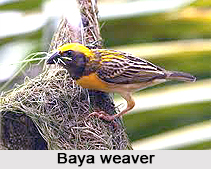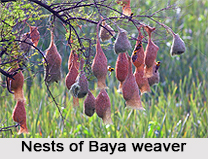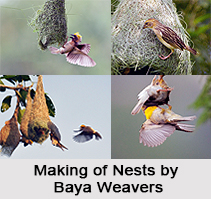 Baya Weaver is an Indian Bird that bears a scientific name "Ploceus philippinus" found in the grasslands, scrubs and the secondary growth.
Baya Weaver is an Indian Bird that bears a scientific name "Ploceus philippinus" found in the grasslands, scrubs and the secondary growth.
Concentration of Baya Weaver
Baya Weaver is a Weaverbird found across the Indian Subcontinent and Southeast Asia. Flocks of these birds are found in grasslands, cultivated areas, scrub and secondary growth and they are best known for their hanging retort shaped nests woven from leaves.
Nests of Baya Weaver
The nests of Baya weaver are in colonies and are usually found on thorny trees or palm fronds and the nests are often built near water or hanging over water where predators cannot reach easily. They are widespread and common within their range but are prone to local, seasonal movements mainly in response to rain and food availability. Nests are built mainly in colonies but isolated nests are not unknown. Nests are often built from thorny Acacia or palm and hang over open water. Young males may build experimental nests among reeds. In Burma, birds often build nests under the eaves of buildings, but this habit is uncommon in India. The males take about 18 days to construct the complete nest with the intermediate "helmet stage" taking about 8 days. The nests are partially built before the males begin to display to passing females by flapping their wings and calling while hanging from their nests. The females inspect the nest and signal their acceptance of a male. Once a male and a female are paired, the male goes on to complete the nest by adding the entrance tunnel. Males are almost solely in charge of nest building, though their female partners may join in giving the finishing touches, particularly on the interiors. Females may modify the interiors or add blobs of mud.
 Size of Baya Weaver
Size of Baya Weaver
Baya Weaver is sparrow-sized (15 cm) and in their non-breeding plumage, both males and females resemble female house sparrows. They have a stout conical bill and a short square tail. Non-breeding males and females look alike, dark brown streaked fulvous buff above, plain (unstreaked) whitish fulvous below, eyebrow long and buff coloured, bill is horn coloured and no mask. Breeding males have a bright yellow crown, dark brown mask, blackish brown bill, upper parts are dark brown streaked with yellow, with a yellow breast and cream buff below.
Behaviours of Baya Weaver
Baya Weavers are social and gregarious birds. They forage in flocks for seeds, both on the plants and on the ground. Flocks fly in close formations, often performing complicated manoeuvres. They are known to glean paddy and other grain in harvested fields, and occasionally damage ripening crops and are therefore sometimes considered as pests. They roost in reed-beds bordering water bodies.
Breeding Season of Baya Weaver
The breeding season of Baya Weaver is during the monsoons. The breeding condition is initiated by environmental characters such as day length and comes to an end after summer although this termination is not influenced by short day length as in temperate birds.
 Nature of Baya Weaver
Nature of Baya Weaver
Both males and females Baya Weaver are polygamous. Males build many partial nests and begin courting females. The male finishes the nest only after finding a mate. The female lays about 2 to 4 white eggs and incubates them for about 14 to 17 days. Males may sometimes assist in feeding the chicks. The chicks leave the nest after about 17 days. After mating with a female the male typically court other females at other partially constructed nests. Intraspecific brood parasitism is known, that is, females may lay their eggs in the nests of others.
Baya weaver in Early India
In earlier times, Baya Weaver was trained by street performers in India for entertainment. They could pick up objects at the command of their trainers. They were trained to fire toy cannons, string beads, pick up coins and other objects. These uses have been noted from the time of Mughal Emperor Akbar.











